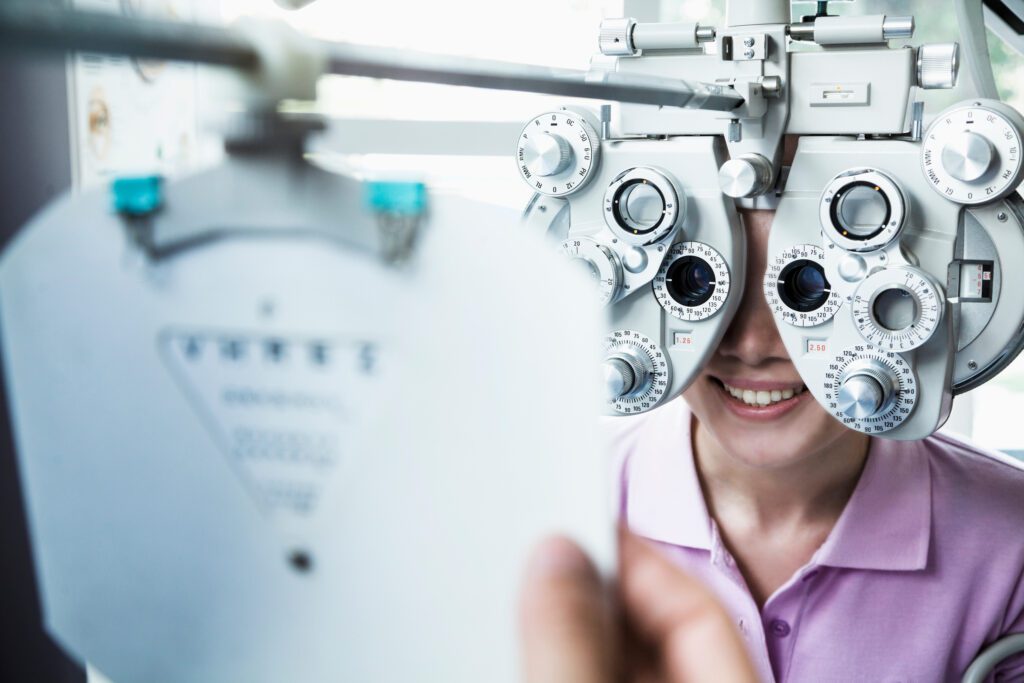When it comes to vision correction, understanding your options is a crucial step toward making the right decision. For many, LASIK eye surgery presents a transformative opportunity to live a life free from the constant need for glasses or contact lenses. But how do you know if you’re a suitable candidate for LASIK? It starts with a thorough pre-operative evaluation. This article delves into the comprehensive LASIK preoperative evaluation process, explaining what we test for and why and detailing the path to your personalized laser vision correction journey. At Waite Vision, your vision is our passion, and the journey toward clear, unaided vision begins with a comprehensive diagnostic work up and LASIK evaluation.
What is LASIK?
LASIK, which stands for Laser-Assisted In Situ Keratomileusis, is a highly effective outpatient procedure widely used for vision correction. This advanced laser vision correction surgery utilizes precision laser technology to reshape the cornea – the clear, front part of the eye – thereby correcting common vision problems like near-sightedness, far-sightedness, and astigmatism.
During LASIK surgery, an ultra-thin flap is created on the cornea’s surface using either a femtosecond laser. The flap is then carefully lifted to expose the underlying corneal tissue. An excimer laser, characterized by its cool ultraviolet light beam, is then used to precisely and gently remove microscopic amounts of tissue from the cornea to reshape it. Once the cornea is reshaped, light entering the eye can be more accurately focused onto the retina, leading to clearer vision.
The corneal flap is then repositioned onto the underlying tissue without the need for sutures. The flap adheres naturally and begins healing quickly. Most patients experience improved vision immediately after the surgery, and visual acuity continues to improve over the following days and weeks.
LASIK offers the prospect of life without total dependence on glasses or contact lenses, opening up a world of freedom in activities, and improving the quality of life. However, to ensure the best possible outcome and minimize risk, a thorough preoperative evaluation is crucial. Waite Vision is dedicated to making this journey as comfortable, informative, and beneficial for you as possible. After all, helping you achieve visual freedom is our ultimate passion.
Are you ready to take the next step in your vision journey?
What is Done in a LASIK Evaluation?
Waite Vision is dedicated to helping you see your world your way, thanks to modern vision correction methods like LASIK (laser-assisted in situ keratomileusis) surgery. To ensure your suitability for this revolutionary refractive surgery and optimize your visual outcome, it’s not helpful to do a quick LASIK scan. A meticulous and thorough preoperative evaluation is critical.
The evaluation involves a detailed history and physical examination, together with several eye tests designed to assess various aspects of your eye health and visual acuity. This isn’t merely a routine eye examination; it’s a comprehensive evaluation of your eye’s specific anatomy, the quality of your vision, and your overall health. This detailed information is essential to help your LASIK surgeon customize your procedure and manage your expectations for the outcome of your LASIK surgery.
History and Physical Examination
In the initial phase, your LASIK surgeon will collect information about your past medical history, including any known eye conditions, your family history, and any relevant systemic diseases such as diabetes. We’ll also explore your medication and drug history, as some drugs may interfere with healing or inflammation control.
Furthermore, the physical examination includes a thorough check of your eyes and their surrounding structures. This includes your eyelids, all layers of the cornea, the lens, vitreous, optic nerve, and retina. Each of these structures will be examined using advanced ophthalmology techniques.
LASIK Testing
To fully assess your suitability for LASIK eye surgery, several tests are performed during your preoperative evaluation. This array of tests assesses your eye’s unique corneal topography, corneal tomography (which takes into account the posterior corneal surface), optical coherence tomography (OCT), optical quality, biometry, pupil reactivity, visual acuity testing, along with dry eye testing. Here’s what each test entails:
Dry Eye Testing: If dry eye syndrome is diagnosed, it can be managed appropriately before LASIK. Tear film stability and vision break up time are among the key measurements taken during this test.
Visual Acuity Testing: This test measures how well your eyes perceive details in varying light conditions, contributing to the overall quality of vision after LASIK.
Pupil Testing: Pupil size is no longer correlated with any visual disturbances after wave-front optimized LASIK. Pupil testing is to assess the reactivity of the pupils and the function of the optic nerves.
Topography: Corneal topography, often known as videokeratography, is a non-invasive medical imaging technique for mapping the surface curvature of the cornea – the clear, front surface of the eye. Given that the cornea is responsible for approximately 70% of the eye’s refractive power, its shape and condition play a critical role in visual acuity. The process involves projecting illuminated rings onto the cornea and capturing the reflection with a camera. The data captured is then computed to generate a topographical map of the eye. This map provides critical information about the cornea’s curvature, shape, and integrity. It also offers corneal wavefront analysis. Corneal topography is especially valuable in refractive surgery, where precise measurements are crucial for optimal outcomes. In LASIK surgery, for example, it allows the surgeon to fully understand each patient’s unique corneal shape, facilitating precise reshaping of the cornea. Waite Vision utilizes advanced corneal topography techniques to ensure we have the most accurate and detailed information about your cornea, allowing us to provide optimal vision correction results.
Tomography: Corneal tomography, also known as corneal computed tomography, is a sophisticated imaging technique that provides a three-dimensional view of the cornea. Unlike corneal topography which primarily provides a map of the front surface of the cornea, corneal tomography maps both the anterior (front) and posterior (back) surfaces of the cornea. It provides detailed information about the cornea’s thickness (pachymetry) across its full area and the elevation and curvature of both corneal surfaces. This comprehensive data allows ophthalmologists to gain a deeper understanding of the cornea’s shape, contour, and depth. It is particularly useful in diagnosing and monitoring conditions such as keratoconus, pellucid marginal degeneration, and other forms of corneal ectasia where the cornea gradually thins and bulges outward. In the context of LASIK, corneal tomography is an invaluable tool in the preoperative evaluation. It helps refractive surgeons assess the suitability of patients for surgery, plan the procedure, and monitor the cornea’s response post-surgery. At Waite Vision, we rely on this advanced technology to ensure a thorough, accurate analysis of your cornea, further solidifying our commitment to safe, effective, and personalized vision correction.
Optical Coherence Tomography: This test is like an MRI of your eye. It allows for a very detailed examination of the layers of the cornea, optic nerve and the retina. Optical Coherence Tomography (OCT) uses non-invasive infrared light rays to map out the layers of the eye in cross sections within a few seconds. This gives us a comprehensive understanding of your cornea, optic nerve and retina. Its ability to facilitate comprehensive pre-operative assessment and aid in post-operative monitoring ensures that patients receive the highest level of care and optimal visual results.
Biometry: This sophisticated tool measures the eye from front to back and side to side giving a comprehensive understanding of the eye to allow for personalized surgical planning. Biometry gives precise corneal curvature, axial length, anterior chamber depth, and lens power measurements. Biometry’s role in enhancing predictability and safety in refractive surgeries like LASIK and cataract removal is indispensable, leading to improved visual outcomes and increased patient satisfaction.
Are All LASIK Consultations the Same?
No, LASIK consultations vary widely from one practice to another. Many LASIK providers only use one machine to determine eligibility for LASIK which leads to patients being squeezed into a vision correction procedure they are not ideal candidates for or being told they are not a candidate when perhaps they are. Waite Vision believes in a meticulous approach to patient evaluation and selection. Your initial consultation includes a full diagnostic workup using five different diagnostic machines and an array of tests with the latest technology to evaluate your eye health. After having your eyes examined, you’ll meet Dr. Waite, your surgeon, and discuss the ideal vision correction surgery tailored specifically for you along with other valuable information regarding the health of your eyes. This comprehensive evaluation helps us deliver excellent visual outcomes while minimizing risk.
Why Can’t You Wear Contacts Before a LASIK Evaluation?
Contact lenses alter the shape of your cornea, and it takes time for your eyes to return to their natural shape after you stop wearing them. This period without contacts is crucial to ensure accurate measurements during your LASIK evaluation. Depending on the type of contact lenses you wear, you may need to stop wearing them for two to four weeks before your evaluation.
How Do I Know if I am a Candidate for LASIK Eye Surgery?
Determining your candidacy for LASIK eye surgery involves a combination of factors: your age, general health, eye health, the stability of your refractive error, and your lifestyle needs are all taken into account.
But it’s not just about your suitability for surgery; it’s also about providing you with a clear understanding of what to expect. We believe in informed consent, where you have all the data necessary to make an informed decision about your vision correction journey. After your LASIK examination you will meet with Dr. Waite to go over the data collected from the advanced diagnostic tests and find out what type of refractive surgery is best for your unique needs.
What Disqualifies You from Being a LASIK Candidate?
Certain conditions and situations might disqualify you from being a LASIK candidate. These include:
Unstable Refraction: If your prescription is still changing, you may need to wait until it stabilizes.
Thin Corneas: LASIK involves creating a flap in the cornea and reshaping its inner layer. If your corneas are too thin, it might pose a risk. Corneal thickness is measured during your evaluation to ensure you are a good candidate for LASIK.
Certain Eye Conditions: Diseases like keratoconus, pellucid marginal degeneration, severe dry eyes and others may prevent you from having LASIK.
Systemic Conditions: Certain autoimmune diseases and medications can affect healing and may be contraindications for LASIK.
Unrealistic Expectations: While LASIK can significantly improve your vision, there may be a rare need for glasses on occasion for certain visual tasks.
In conclusion, LASIK eye surgery is a fantastic option for those who wish to reduce or eliminate their dependence on corrective lenses. However, a thorough preoperative LASIK evaluation is critical to determine your suitability for the procedure, minimize risk, and achieve the best possible outcome. At Waite Vision, we are committed to providing comprehensive patient education, utilizing cutting-edge technology, and delivering personalized care to help you see your world, your way.
So, are you ready to take the first step towards clear vision without the need for contacts or glasses? Don’t wait another day to begin your journey towards improved eyesight. Schedule your comprehensive preoperative LASIK evaluation with our experienced LASIK surgeons at Waite Vision today. You can contact us online or call our office to arrange your appointment.
Remember, it’s more than just an eye examination; it’s a step towards a world seen your way. Your vision is our passion at Waite Vision, and we’re excited to help you unlock the potential of your vision with modern vision correction. Let us guide you to a life less dependent on glasses or contact lenses. Start your journey to better vision today.

